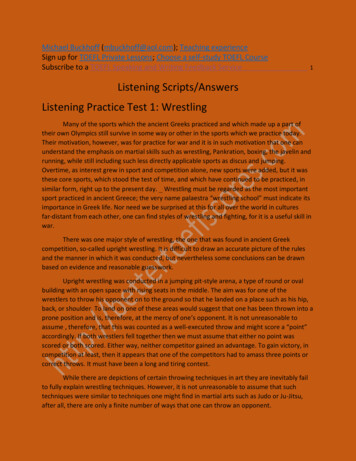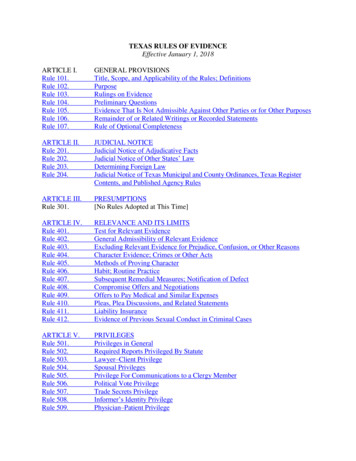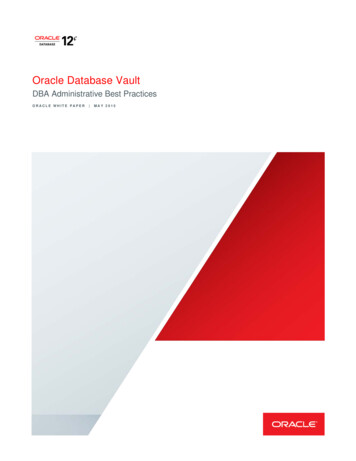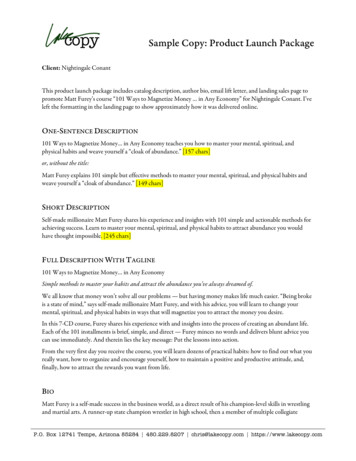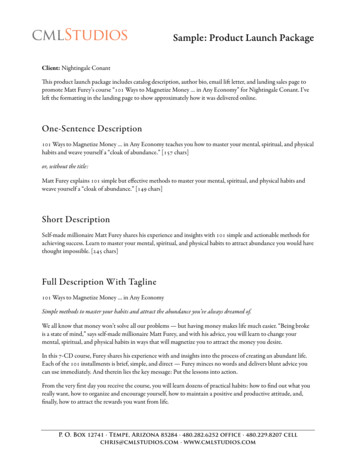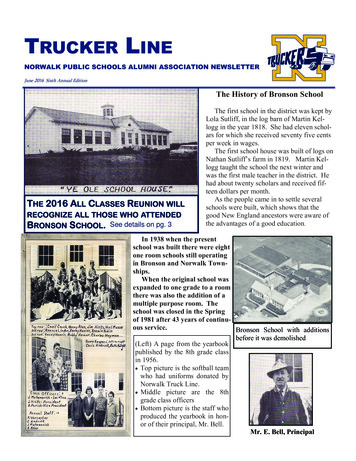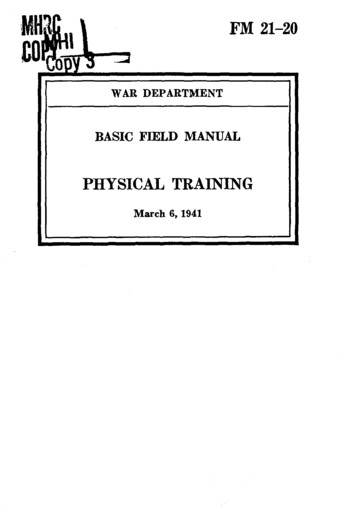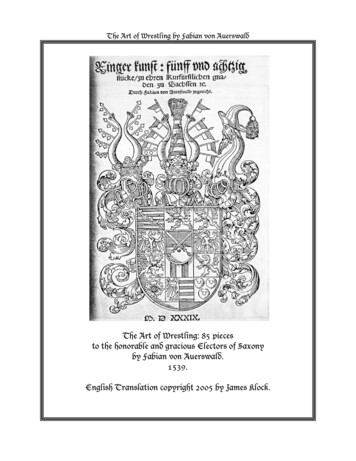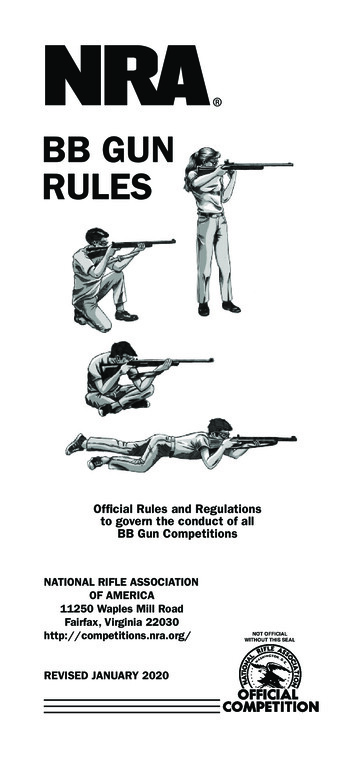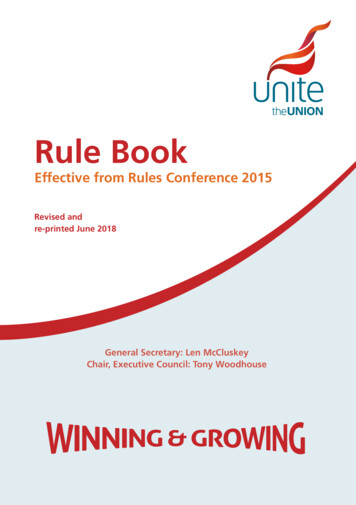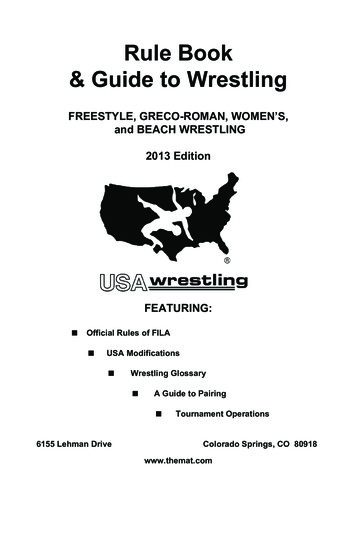
Transcription
Rule Book& Guide to WrestlingFREESTYLE, GRECO-ROMAN, WOMEN’S,and BEACH WRESTLING2013 EditionFEATURING: Official Rules of FILA USA Modifications Wrestling Glossary A Guide to Pairing Tournament Operations6155 Lehman DriveColorado Springs, CO 80918www.themat.com
International Rule Book& Guide to WrestlingFREESTYLE, GRECO-ROMAN, WOMEN’S WRESTLING,and BEACH WRESTLING2013 EditionThe 2013 Rule Book & Guide to Wrestling is produced by theDepartment of State Services of USA Wrestling, in cooperation with theUSWOA. For the most up to date version of the Rule Book, please visitwww.themat.com/forms/Rulebook.pdf.USA Wrestling (USAW) is the National Governing Body for the sport inthe United States and is the authorized representative to the United StatesOlympic Committee (USOC), and to the Federation Internationale des LuttesAssociees (FILA).This rule book contains the rules of FILA, which are approved by the USAWBoard of Directors to be utilized at USAW sanctioned Freestyle, Greco-Roman,Women’s, Beach Wrestling events, as well as USAW sanctioned GrapplingEvents. Please note the various USAW modifications to the FILA ruleswhich were also adopted by the USAW Board of Directors. The revised 2013FILA International Rules are made available to download at www.themat.comand are enforced for those events that apply.USA WRESTLINGJames Ravannack . . . . . . . . . . . . . . . . . . . . . . . . . . . . . . . . . . . . . . . PresidentRick Tucci . . . . . . . . . . . . . . . . . . . . . . . . . . . . . . . . . . . . . President, USWOARich Bender . . . . . . . . . . . . . . . . . . . . . . . . . . . . . . . . . . . . . Executive Director
USA WrestlingRapid Weight Reduction RuleWhereas rapid weight reduction “cutting weight” through caloric restriction,dehydration, and excessive exercise in heated environments exposeswrestlers to decreased performance, heat related trauma, and hazard to healthand life, USA Wrestling (USAW) has adopted the following rules:With regard to the practice of dehydration, the use of hot rooms, hot showers,hot boxes, saunas, steam rooms, heating devices, diuretics, emetics, laxatives,excessive food and fluid restriction and self-induced vomiting is prohibited byUSA Wrestling.Regardless of purpose, the use of vapor-impermeable suits (e.g., rubber orrubberized nylon) is prohibited.Violation of these rules at USAW sanctioned events shall cause theindividual(s) in question to be suspended from the competition for which use ofthe prohibited methods were intended.Enforcement for this rule shall be the responsibility of the tournamentcommittee which is to be established prior to the competition. The decision ofthe tournament committee shall be final.A second event violation will result in the suspension of the individual(s) fromany USAW sanctioned event for one calendar year from time of suspension.All second violation cases shall be heard by the appropriate age groupexecutive committee. USAW’s By-laws shall be considered in all applicablecases.Any individual assisting an athlete in prohibited weight reduction practicesshall be held to the same rules and penalties as athletes.USAW discourages rapid weight reduction methods under any circumstances.However, events excluded from these rules are Senior-level FILA calendarevents and Senior-level FILA “world level championships” and those Seniorlevel competitions which are qualifying events for Senior-level FILA “worldlevel championships”.Guidelines for Application of the Rule:1. This rule shall be in effect for all USAW sanctioned events (exceptthose excluded above).2. The tournament committee of each event must put its decision inwriting to both the offending party and the USA Wrestling National Office.3. The rule will be posted/distributed at the competition venue(s), weighin site(s), practice venue(s), host hotel(s), training site(s) and official housingfacilities(s). In addition, announcements will be made on the public addresssystem throughout the weigh-ins, if possible, and during the competition.2
IntroductionThere are two basic styles of international wrestling, Freestyle and GrecoRoman. With one major exception, the rules for the two styles are identical.The difference is: In Greco-Roman, a wrestler may not attack his opponent’slegs, nor use his own legs to trip, lift or execute other holds. In Freestyle, however, both the arms and legs may be usedto execute holds and to defend against attack.These definitions bring about variations in stance and technique, and insome interpretations of the rules, but the requirements for scoring points, forwinning and losing, and for advancement through an event are in general thesame for both styles. A wrestler’s goal is to pin his opponent’s shoulders to themat, or else to win on points.Although freestyle wrestling bears a resemblance to the folkstyle practicedin American scholastic and collegiate programs, there are major differencesbetween the national and international styles. Over the past decade, theInternational Federation of Associated Wrestling Styles (FILA) has changedthe whole direction of the sport.The objective is to make wrestling vigorous, dynamic and spectacular.This is being carried out by revisions of the rules and their interpretations, bymodifications of the methods of pairing, scoring and advancement, and byintroduction of new philosophy.FILA also recognizes two other styles of wrestling each with their ownrules, they are Beach Wrestling and Sombo. Details on the rules for these twostyles can be obtained through USAW.Modern WrestlingBeginning in 2005, FILA adopted sweeping rule changes that changedthe image of the sport for the future. On recommendation by various USAWrestling Age Group Councils and Standing Committees, the USA WrestlingBoard of Directors voted that these sweeping rules changes be enforcedbeginning in 2006, with some modifications. This rule book contains the FILArules, modification to the rules made by USAW for age group competitionsand the rules for Beach Wrestling. All Senior level events and FILA eventssanctioned in the United States will adhere to the “new” FILA rules with somemodification to the pairings procedures, weigh-ins and protest procedures.Regardless of what rules are utilized, there are some basic principals thatgovern the sport overall and the application of any rules currently in place, orthat shall be adopted in the future. The principals are as follows:Passivity (stalling) is the worst enemy of wrestling. Any attempt to avoidwrestling — by blocking, by pushing, by going out of bounds, by “playing theedge”.3
Total wrestling defines the dynamic, “all-out” aspect of the sport. Thewrestlers are expected to attack and counterattack continuously during thewrestling time.Universal wrestling is an essential quality of total wrestling. It calls for thedevelopment of new techniques and the use of a wide variety of actions andholds.“Risk:” In all sports, attack and defense imply a certain amount of “risk.” Astrong wrestler has the courage to take “risks.” Fear and the reluctance to take“risks” should not be a part of wrestling.Age Group CompetitionUSA Wrestling sanctions competitive opportunities in Freestyle, GrecoRoman, Beach Wrestling, Sombo and Folkstyle wrestling for all ages andin varying levels of intensity. These programs are not intended to replacescholastic and collegiate folkstyle wrestling, but rather to allow each individualto broaden his/her horizons, increase his/her technical skills and establish newgoals.One of the advantages of wrestling Freestyle, Greco-Roman, Beachand Sombo is that these styles make up an individual sport. Although cluband state awards are presented, the wrestler does not have the pressure ofperforming for his school, the fear of letting down his team. He/she is free towrestle to win, rather than half-wrestle not to lose.The club coach most likely is a volunteer. His/Her professional job and his/her family’s livelihood do not depend on the performance of a team. He/sheis free to teach new technique, and to encourage his wrestlers to utilize thesenew skills.The officials also are volunteers. Generally, there are three on a mat freeto make swift, objective decisions about scoring and to enforce the rules andthe spirit of the rules. Pairing officials apply standard formulas and procedures,without the need for subjective judgment.Wrestling in the international styles is the ultimate participation in TheOldest Sport.USA Wrestling in general follows the Freestyle, Greco-Roman, Grappling,and Beach Wrestling rules of the international governing body, FédérationInternationale des Luttes Associées, known as FILA, with modifications fordomestic and age group competition. Not all aspects of the internationalrules are adhered to, and local and state conducted events may includeother modifications. As part of its continuing education effort, USA Wrestlingpresents the 2013 Edition of Guide to Wrestling in the international styles,including the official rules of FILA and guidelines for pairing and tournamentoperations.USA Wrestling State Associations & Grass Roots VisionStatement: The vision of USA Wrestling is to be the preeminent, mostprominent and highly regarded sport organization in the World using OlympicIdeas to assist all in achieving their maximum human potential.4
INTERNATIONAL FEDERATION OF ASSOCIATED WRESTLING STYLESINTERNATIONAL WRESTLING RULESGRECO-ROMAN WRESTLING - FREESTYLE WRESTLINGWOMEN’S WRESTLING - BEACH WRESTLINGINDEXGENERAL RULES PageArticle 1 Object 8Article 2 Interpretation 9Article 3 Application 9CHAPTER 1 - MATERIAL STRUCTUREArticle 4 The matArticle 5 Competitor’s dressArticle 6 Competitor’s licenceArticle 7Age and weight categories10111313CHAPTER 2 - COMPETITIONS AND PROGRAMMESArticle 8 Competition system 16Article 9 Competition programme 19Article 10Award ceremonies19CHAPTER 3 - COMPETITION PROCEDUREArticle 11Weigh-inArticle 12Drawing of lotsArticle 13Starting listArticle 14PairingArticle 15Elimination from the competition2021222222CHAPTER 4 - REFEREEING BODYArticle 16CompositionArticle 17General dutiesArticle 18Referee’s dressArticle 19The refereeArticle 20The judgeArticle 21The mat chairmanArticle 22The Jury of AppealArticle 23Penalties against the refereeing body2324252526272829CHAPTER 5 - THE BOUTArticle 24Duration of the boutArticle 25Call to the matArticle 26Presentation of wrestlersArticle 27StartArticle 28Interrupting the boutArticle 29End of the bout2929303030315
Article 30Article 31Article 32Article 33Article 34Article 35Article 36Interrupting and continuing the boutExtra time (freestyle and female wrestling)Types of victoriesThe coachThe challengeTeam ranking during individual competitionsRanking system during team competitions31323233343535CHAPTER 6 - POINTS FOR ACTIONS AND HOLDSArticle 37Evaluation of the importance of the action or holdArticle 38Danger positionArticle 39Recording the pointsArticle 40High amplitude throwArticle 41Value assigned to the actions and holdsArticle 42Decision and voteArticle 43Decision table36373838384041CHAPTER 7 - CLASSIFICATION POINTS AWARDED AFTER A BOUTArticle 44Classification points42Article 45The fall 42Article 46Technical superiority43CHAPTER 8 - NEGATIVE WRESTLINGArticle 47Par terre position during the bout43Article 48Red zone 44Article 49Ordered hold 45CHAPTER 9 - PROHIBITIONS AND ILLEGAL HOLDSArticle 50General prohibitionsArticle 51Fleeing a holdArticle 52Fleeing the matArticle 53Illegal holdsArticle 54Special prohibitionsArticle 55Consequences affecting the bout495051515353CHAPTER 10 - THE PROTESTArticle 56The protest 54CHAPTER 11 - MEDICALArticle 57Medical service 56Article 58Medical service interventions56Article 59Doping 58CHAPTER 12 - APPLICATION OF WRESTLING RULES58APPENDIX 1 - BASIC VOCABULARYAPPENDIX 2 - BEACH WRESTLING59616
USAW Modifications: Modifications to the 2013 international rules, madeby USAW to enhance the sport in the United States, are in some cases notedafter the text of the international rules in italics or can be found in the sectiontitled ”USA Modifications.”See page 136 for USAW Modifications Index7
FOREWORDWrestling, like all other sports, obeys rules which constitute the“Rules of the Game” and define its practice, the aim of which is to “pin”the opponent or to win on points. These regulations apply to all the stylesrecognized by modern wrestling controlled by the FILA.The Greco-Roman Style and Freestyle basically differ as follows: In Greco-Roman Wrestling, it is strictly forbidden to grasp theopponent below the belt line, or to trip him or to use the legs activelyto perform any action. In Freestyle wrestling, however, it is permissible to grasp the legs ofthe opponent, to trip him and to use the legs actively to perform anyaction.Double Nelsons are strictly forbidden in women’s wrestling.Beach wrestling is dealt with by a specific rule.Traditional wrestling, as practiced world wide, are subject to specific rules.Frequently modified and always subject to further modification, the Rules setforth herein must be known and accepted by all wrestlers, coaches, refereesand leaders. They call upon those who practice the sport to fight totallyand universally, with complete honesty and fair play for the pleasure of thespectators.FILAINTERNATIONAL FEDERATION OF ASSOCIATED WRESTLING STYLESINTERNATIONAL WRESTLING RULESGRECO-ROMAN WRESTLING - FREESTYLE WRESTLING - WOMEN’SWRESTLINGGENERAL RULESArticle 1 - ObjectDrawn up in compliance with the FILA Constitution, the Financial Regulations,the Disciplinary Regulations, the General Rules governing the organization ofinternational competitions, and all the specific Regulations, the InternationalWrestling Rules have as their specific objectives to:-define and specify the practical and technical conditions under whichbouts are to take placedetermine the value to be assigned to wrestling actions and holds8
-list situations and prohibitionsdetermine the technical functions of the officialsdetermine the competition system, methods of victory, defeat,classification, penalty, elimination of competitors, etc.Being subject to modification in light of practical observations as to theirapplication and research into their effectiveness, the international Rules setforth in the following document constitute the framework within which the sportof wrestling is conducted in all its styles. Traditional wrestling, Sambo andBeach Wrestling are governed by rules specific to the various styles.Article 2 - InterpretationIn the event of disagreement as to the interpretation of the provisions ofany article in the following Rules, the Executive Bureau of FILA is solelyempowered to determine the exact meaning of the article(s) in question. TheFrench text shall prevail.Article 3 - ApplicationApplication of these Rules to the Olympic Games, Championships, and to allinternational competitions under the control of FILA is compulsory.During international tournaments, a competition procedure that differs fromthat set out in the Rules may exceptionally be used, provided that permissionhas been granted by FILA and all participating countries.In the United States, the rules of the sport and modifications to the 2013FILA rules shall be used at all regional and national events, except whereasnoted above. State and local competitions are encouraged to use these rulesfor consistency from competition to competition.9
CHAPTER 1 - MATERIAL STRUCTUREArticle 4 - The matUSAW Modification In the USA, where mats are manufactured forwrestling competition, the passivity zone may be marked by taping a line ofdashes inside the out-of-bounds line. The inner 10-foot folkstyle circle hasno meaning internationally, and when standing, the contestants start in themiddle, facing each other about a yard apart.One corner of the mat should be marked in red and another in blue, sothe wrestlers and the coaches know where to report. This can be done withcolored chairs, with colored plywood under the chairs, or simply with redand blue signs. The red corner should be on the referee’s left as he facesthe mat chairman’s table. FILA approved mats are not required for domesticcompetition.For local and state level competitions for the age groups Schoolboy/girland lower, mats less than full size but not less than a quarter of a full sized(standard) mat may be used when necessary. Adequate protection around allmats should be in place.A new FILA approved mat, with a 9 m diameter and surrounded by a 1.50 mborder of the same thickness is obligatory in the following contests: OlympicGames, Championships and Cups. For all international competitions, matsmust be homologated, but not necessarily new.For the Olympic Games and World Championships, warm up andtraining mats must also be new and approved by FILA and be of the samequality as the competition mats.A red band of 1 m wide and forming an integral part of the wrestlingarea is drawn along the circumference on the inside of the circle of 9 m indiameter.The following terms will be used to designate the various parts of themat:The central circle indicates the middle of the mat (1 m diameter). The inside part of themat which is inside the red circle is the central surface of wrestling (7 m of diameter).The red strip (1 m width). The area in the protection area is 1.50 m width10
For all Olympic Games, World Championships and Continental Championships,the mat shall be installed on a platformnot higher than 1m10 or lower than 0m50.If the mat lays on a podium and that the protection margin (covering and freespace around the mat) does not reach 2 meters, the sides of the podium willhave to be covered with 45 inclined panels. In all cases, the color of theprotection area will have to be different from the one of the mat.The wooden floor near the mat will have to be covered with a strongly wellfixed soft cover.To prevent contamination, the mat must be washed and disinfected beforeevery wrestling session. When mats that have a smooth, uniform and nonabrasive surface are used (canvas included), the same hygienic measuresmust also be applied.A circle must be traced in the middle of the mat with an inside diameter of onemeter and a surrounding band 10 cm wide. For Greco-Roman wrestling, an 8cm width line splits the circle in two parts. The color of the line just describedand that of the line marking off the wrestling area must be red.The diagonally opposite corners of the mat are marked out in the wrestlers’colors, red and blue.The mat should be installed so that it is surrounded by a wide open space inorder to ensure that the competition proceeds normally.Article 5 - Competitor’s dressUSAW Modification: (a) Singlet: The singlets for Cadet, FILA Cadet andJunior Division National Championships are to be colored predominantly aclearly distinguishable shade of either red or blue. Red and blue may bemixed as long as the provisions above remain. No specific rules for any othercompetitions, (b) For Cadet and Junior Division National Championships,athletes must wear their state approved singlet, (c) The use of protectiveheadgear of a type required for scholastic wrestling is authorized andrecommended in Junior, Cadet, FILA Cadet competition. Headgear is allowedin Senior, University and FILA Junior World competition, but must be removedat the request of the opponent unless it is worn for a certified medical reason.Headgear is mandatory for all 14 and younger USAW Regional and NationalChampionships. In any division, a face mask is allowed only to protect anexisting injury, or an injury occurring during the bout, and must be prescribedby a medical doctor or the event’s chief medical officer. (d) Competitors arerequired to tape their shoe laces down to avoid unfastening.At the beginning of each day, each competitor must be closelyshaven or have a beard of several months growth.a)The competition singletContestants must appear on the edge of the mat wearing a FILA approvedone-piece singlet of the colour assigned to them (red or blue). It is forbiddento have a mixture of red and blue colours on the singlet. Only for the11
USAW Senior Team Trials shall athletes be required to wear the “high cut”singlet as stipulated by FILA. The use of a two-piece singlet/uniform is notallowed at any freestyle or Greco-Roman USAW Developmental Age GroupRegional or National Championships. Folkstyle wrestlers are allowed towear compression or board shorts and a tight-fitting sleeveless, short, or longsleeve shirt (shorts shall not be excessively baggy or have pockets, buttons, orsnaps). For any regional, national, or international competitions held inthe United States, female competitors must wear a women’s cut singlet.The wrestler must wear:Their country’s emblem on his chest.The abbreviation of the country’s name (maximum size 10 cm x 10cm) on the back of the singlet and the last name in latin letters(4 cm to 7 cm) above or in a half circle around the country’sabbreviationThe use of light knee pads containing no metal parts is allowed.The wrestler must have a cloth handkerchief with him during thewhole of the match.b)Advertising on clothingApart from during the Olympic Games where the IOC Rules apply,competitors can wear one or several sponsor’s names. Contestants may alsowear their sponsors’ name(s) on the back or sleeves of their robes. Letteringand symbols may not be higher than 6 cm to identify the sponsor.c)Ear protectorsFor those wrestlers who wish to wear ear protectors, they must beapproved by FILA and must not contain any metal or have hard shells.The referee can oblige a wrestler with too long hair to wear earprotectors. (Standard headgear manufactured in the United States may beworn for all domestic USAW events. Headgear is mandatory of 14 years andyounger athletes at all USAW Regional and National competitions.)d)ShoesContestants must wear wrestling shoes providing firm support for theankles. The use of shoes with heels or nailed soles, shoes with buckles or withany metallic part, is prohibited. Shoes may be without laces. Shoes with lacesshould be wrapped with sticky tape or a system which hides laces so that theydo not come undone during the match. Each competitor is responsible forproviding the tape himself for the shoes which will be controlled before gettingon to the mat.e)BansAt the weigh-in, the referee must check that each competitor satisfiesthe requirements of this article. The wrestler must be warned at the weighin that, if his appearance is not correct, he will not be allowed to enter thecompetition. If the wrestler enters the mat with a non compliance appearance,officials will allow maximum one minute in order for him to comply. If, after thistime, the wrestler is still at fault, he will lose the match by abandon.12
It is prohibited to:Wear the emblem or abbreviation of another country.Wear bandages on wrists, arms or ankles except in the case of injuryand on doctor’s orders. These bandages must be covered withelastic straps.Apply any greasy or sticky substance to the body.Arrive at the mat perspiring for the beginning of the match as well asat the beginning of each period.Wear any object that might cause injury to the opponent, such asrings, bracelets, prosthesis, etc.Wear underwired bras for female wrestlers.Article 6 - Competitor’s licenceAny male or female senior wrestler who competes in the OlympicGames, World Championships, World Cups, Continental Championships,Cups and Games, Regional Games and the World and Continental League,international tournaments registered in the FILA calendar must hold aninternational competitor’s licence, as defined by special Regulations. ForUSAW events, all competitors must be current members of USAW.Any male or female cadet, junior wrestler who competes in theContinental and World Championships must hold an international competitor’slicence.Any male or female junior wrestler who competes in a seniorinternational tournament must hold an international competitor’s licence.Any veteran wrestler who competes in the World Championships andother international competitions must also hold an international competitor’slicence.This licence is also used as insurance for medical and hospitalexpenses in case of an accident taking place during competitions he isparticipating in.The competitor must, at the time of the weigh-in, present his licenceto the official delegate who, in turn shall submit it for verification to theFILA representative. The latter shall return it on the same day to the teammanager of the said competitor. For competitions in which no accreditation isorganised, these documents must be presented at weigh-in.The licence is valid only when it bears the FILA stamp for the currentyear, and must be renewed each year.Article 7 - Age and weight categoriesa)Age categoriesThe age categories are as 5 years (from 13 with medical and parental certificate)16-17 years (from 15 with medical and parental certificate)18-20 years (from 17 with medical and parental certificate)20 years and olderolder than 35 years13
Wrestlers in the junior age category are allowed to participate in thecompetitions for seniors. However, wrestlers aged 18 in the year concernedmust provide a medical certificate and parental authorization. Wrestlers aged17 in the year in question may not participate in senior competitions.Age will be verified at all Championships and competitions during theaccreditation.An honour certificate for each participant will be issued by thePresident of the National Federation attesting to the age of the wrestler; thiscertificate must be drawn up in accordance with the model supplied by FILA,on the National Federation’s letterhead.A wrestler may participate in a competition only under the nationalityappearing on his passport. If, at any time, it is determined by FILA that thestatement was false and that fraud occurred, the disciplinary measuresprovided for to this end will be immediately applied against the Federation, thewrestler and the person whose signature appears on the fraudulent certificate.Wrestlers who change their nationality and wish to participate in aninternational competition with their new country must wait two (2) years aftertheir last competition registered in the FILA calendar. Wrestlers can changetheir nationality only once. Afterwards, they cannot compete for their oldcountry anymore.Each wrestler who participates in a competition automatically agreesto FILA and USAW to use his filmed or photographed image for the promotionof the competition or of competitions to come. If a wrestler refuses to agree tothese conditions, he will have to make this clear at the entry stage and, maytherefore be excluded from the competition.b)Weight categoriesThe weight categories for freestyle and Greco-Roman are as follows:(USAW weight classes differ)SCHOOLBOYSCADETSJUNIORS1. 29-32 kg2. 35 kg3. 38 kg4. 42 kg5. 47 kg6. 53 kg7. 59 kg8. 66 kg9. 73 kg10. 73-85 kg1. 39-42 kg1. 46-50 kg1. 50-55 kg2. 46 kg2. 55 kg2. 60 kg3. 50 kg3. 60 kg3. 66 kg4. 54 kg4. 66 kg4. 74 kg5. 58 kg5. 74 kg5. 84 kg6. 63 kg6. 84 kg6. 96 kg7. 69 kg7. 96 kg7. 96-120 kg8. 76 kg8. 96-120 kg9. 85 kg10. 85-100 kg14SENIORS
The weight categories for female wrestling are as followsSCHOOLBOYSCADETSJUNIORS1. 29-32 kg2. 35 kg3. 38 kg4. 42 kg5. 47 kg6. 53 kg7. 59 kg8. 66 kg9. 73 kg10. 73-85 kgSENIORS1. 39-42 kg1. 46-50 kg1. 50-55 kg2. 46 kg2. 55 kg2. 60 kg3. 50 kg3. 60 kg3. 66 kg4. 54 kg4. 66 kg4. 74 kg5. 58 kg5. 74 kg5. 84 kg6. 63 kg6. 84 kg6. 96 kg7. 69 kg7. 96 kg7. 96-120 kg8. 76 kg8. 96-120 kg9. 85 kg10. 85-100 kgEach contestant deemed to be taking part of his own free will, and responsiblefor himself, shall be allowed to compete in only one weight category: the onecorresponding to his weight at the time of the official weigh-in.For categories in the senior age group (all age groups for USAW competitions),competitors may opt for the next higher category than their body weight,except for the heavy weight category, for which contestants must weigh over96 kg (females over 67 kg), or the highest weight class prior to last weightclass of the appropriate age group for USAW competitions. Rules differ forNational Dual Championships.c)CompetitionsInternational competitions for the various age categories are as follows:(USAW age groups and competitions differ)Schoolboys (14-15 years) International competitions (bilateral andregional)Cadets (16-17 years)International competitionsContinental Championships(each year)Juniors (18-20 years)International competitionsContinental Championships(each year)World Championships (each year)Seniors (20 years and older) International competitionsContinental Championships(each year)Continental Cups (each year)World Championships (each year,apart from Olympic Games years)World Cup (each year)Golden Grand PrixChallenge matchesInternational Grand PrixSuper Star matchesOlympic Games (every four years)Veterans (35 years and older) Competitions according to the programme (eachyear)15
Categories and specific regulationsAll the above-mentioned competitions will be conducted according to FILARules, Statutes and Regulations, or as modified by USAW for domesticcompetitions, which shall use the 2013 FILA Rules as modified by USAWrestling, and with exceptions herein noted.CHAPTER 2 - COMPETITIONS AND PROGRAMMESArticle 8 - Competition systemCompetition System and MethodUSA Wrestling competition procedures may be found on page 61.The competitions take place by direct elimination system with anideal number of wrestlers, i.e. 4, 8, 16, 32, 64, etc. If there is no ideal numberof wrestlers in a category, qualification matches will take place.Pairing is made in the order of the numbers drawn at random. Allwrestlers who lost against both finalists will have repêchage matches. Thereare two separated groups of repêchage : one group of wrestlers who lostagainst the first finalist, an
and Beach Wrestling rules of the international governing body, Fédération Internationale des Luttes Associées, known as FILA, with modifications for domestic and age group competition. Not all aspects of the international rules are adhered to, and local an
